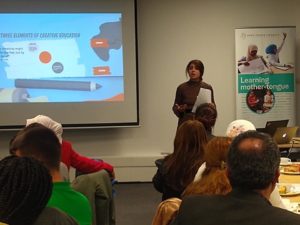by Iman Bahmanabadi
NRCSE has always been occupied with how we can provide support for supplementary schools and out of school settings with regards to building creative channels within their teaching. But why does creativity matter?
Firstly, core to the very nature of education, is creativity. Creativity is normally categorised and quarantined off in merely being a vehicle to present ideas in the arts such as music and dance. However, creativity is quintessentially a means of learning through developing a personal understanding of the material, in any subject. Maths for example is as much about posing problems as problem solving, and recognising within a situation that there is a question waiting to be asked. Creativity is in noticing there is something to be investigated in contrast to having the knowledge to answer a question when a question is posed. Even in simple things such as giving students the answers and having them to work backwards encourages creativity as it unlocks a different perspective in how to tackle the situation and in turn enhance one’s understanding of the material. Having creativity not seem like it only belongs in the arts from an early age but rather an interactive way of communicating ideas, students can develop intricate cognitive processes, that in turn allow them to map out the links from subject to subject, as opposed to having the clear divide of the sciences & the arts.
Creativity is all the more vital in supplementary schools. By means of having a piece of existing material and adapting it in order to be taught to a certain demographic, in a certain language, within the framework of a certain culture, is inherently creative. For years, supplementary schools have endeavoured in having their students recognise the richness of their heritage and the arts have been a fundamental tool in signifying that. Creativity actively seeks for the participation of the student and in doing so, they not only develop ideas but a sense of who they are as they are being welcomed to use their own cognition and to form an identity for themselves. I speak on behalf of personal experience in that I grew up in high school, however I was raised by my supplementary school as it gave me that space to see who I was within the greater context of my own community.
However, with the presence of COVID-19, it is clear that creativity within the classroom setting has been challenged. Where students were the active participators of their own creativity, they now face the difficulty in being confined to a remote space, unable to engage with their classmates. NRCSE’s ARTIS collaborative project as well as our webinars with Joe Dale and forum meetings have been paramount in hearing these difficulties but also in seeing what can be done. We live in a new age now; the digital age. Where previously students were challenged by the proposals of the teachers, now, teachers are being confronted to follow their own philosophy and to use what they know and adapt it in light of the circumstances i.e. to be creative. On educational terms, the lockdown can be seen as cathartic for students and teachers alike. It has provided them a time to become aware of the modernisation of education and to engage with the online realm to become more resourceful, more efficient and ultimately, more creative. Where teachers were content in their materials, they are now exploring and adapting online materials to form personal and interactive lesson plans. This is developing a new language between teacher and student, refreshing the ideas of what education can mean and this is why creativity matters.


Leave a Reply
You must be logged in to post a comment.